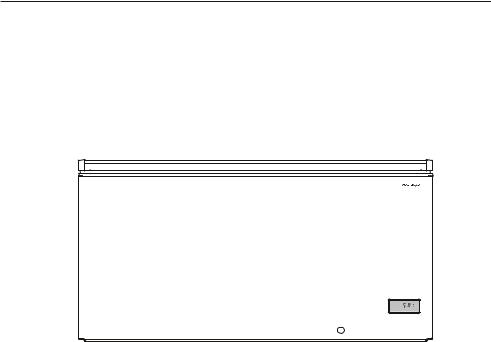Fisher & Paykel RC143W1, RC201W1, RC376W1, RC519W1, RC719W1 User Manual

INSTALLATION INSTRUCTIONS
USER GUIDE
Chest Freezer
RC143, RC201, RC376, RC519 and RC719 models
NZ AU

CONTENTS
Introduction |
3 |
Safety and warnings |
4 |
Installation instructions |
7 |
Moving or storing your appliance |
10 |
Chest freezer operating instructions |
11 |
Chest freezer special features |
12 |
Chest freezer cleaning and care instructions |
13 |
Storing food in your chest freezer |
15 |
Troubleshooting |
17 |
Manufacturer’s Warranty |
19 |
Customer Care |
21 |
IMPORTANT!
SAVE THESE INSTRUCTIONS
The models shown in this user guide may not be available in all markets and are subject to change at any time. For current details about model and specification availability in your country, please go to our website www.fisherpaykel.com or contact your local Fisher & Paykel dealer.
Registration
Register your product with us so we can provide you with the best service possible.
To register your product visit our website: www.fisherpaykel.com
1

INTRODUCTION
Thank you for buying a Fisher & Paykel chest freezer.
At Fisher & Paykel we are very proud of this appliance. This appliance combines size and storage space with the latest features and functions.
We hope you enjoy your new appliance.
RC519 chest freezer
The diagram above shows an example of one of the models covered in this book.
3

SAFETY AND WARNINGS
!WARNING!
Electric Shock Hazard
Read and follow the safety and warnings outlined in this user guide before operating this appliance.
Failure to do so can result in death, electric shock, fire or injury to persons.
This appliance contains flammable refrigerant isobutane (R600a).
R600a
Use this appliance only for the intended purpose as described in the user guide.
IMPORTANT SAFETY INSTRUCTIONS:
WARNING!
When using this appliance always exercise basic safety precautions including the following:
●●This appliance can be used by children aged from 8 years and above and persons with reduced physical, sensory or mental capabilities or lack of experience and knowledge if they have been given supervision or instruction concerning use of the appliance in a safe way and understand the hazards involved.
●●Children should be supervised to ensure that they do not play with the appliance.
●●Cleaning and user maintenance shall not be made by children without supervision.
●●The manufacturer’s installation instructions must be followed when installing the appliance.
●●WARNING: Do not use mechanical devices or other means to accelerate the defrosting process, other than those recommended by the manufacturer.
●●WARNING: Do not damage the refrigerant circuit.
●●In case of damage to the refrigerant circuit, ventilate the area by opening all windows. Do not operate electrical equipment or any other equipment that may produce arcs, sparks or flames in the area. Contact your Fisher & Paykel trained and supported service technician immediately to arrange for the appliance to be repaired.
●●It is hazardous for anyone other than an authorised service person to service this appliance. In Queensland the authorised service person must hold a gas work licence or authorisation for hydrocarbon refrigerants to carry out service or repairs which involve removal of covers.
4

SAFETY AND WARNINGS
Electrical
●●This appliance must be installed in accordance with the installation instructions before use.
●●To allow disconnection of the appliance from the supply after installation, incorporate a switch in the fixed wiring in accordance with the wiring rules.
●●Never unplug your appliance by pulling on the power cord. Always grip the plug firmly and pull straight out from the outlet.
●●Do not plug in any other appliance at the same power point as your chest freezer or use extension cords or double adapters.
●●Repair or replace immediately all electric service cords that have become frayed or otherwise damaged. Do not use a cord that shows cracks or abrasion along its length or at either the plug or appliance end.
●●If the power supply cord is damaged, it must only be replaced by your Fisher & Paykel trained and supported service technician because special purpose tools are required.
●●When moving your appliance away from the wall, be careful not to roll over or damage the power cord.
●●WARNING: Do not use electrical appliances inside the food storage compartments of the appliance, unless they are of the type recommended by the manufacturer.
IMPORTANT!
Your appliance is designed to operate for many years without the need for service checks. However, if your appliance is malfunctioning, have it attended to by your Fisher & Paykel trained and supported service technician as soon as possible. All electrical repairs must be carried out by an adequately trained service technician or qualified electrician.
Cleaning
●●Many commercially available cleaning products contain solvents that may attack the plastic components of your appliance and cause them to crack.
●●Avoid using anti-bacterial cleaning products on either the interior or exterior of the cabinet as they may cause rusting of metal components and cracking of plastic components.
●●Please refer to the ‘Chest freezer cleaning and care instructions’ section of this user guide for further information.
Disposal
●●Extreme care must be taken when disposing of your old appliance to avoid hazards:
–The flammable refrigerant gas must be safely removed.
–The thermal insulation foam in this appliance contains flammable insulation blowing gases, any exposed foam may be highly flammable and must be carefully treated during disposal.
–The lid should be removed and the freezer baskets left in place so that children may not easily climb inside.
●●Your Fisher & Paykel trained and supported service technician will be able to give advice on environmentally friendly methods of disposing of your old appliance or freezer.
5

SAFETY AND WARNINGS
Storing food and drinks
●●Do not store explosive substances such as aerosol cans with a flammable propellant in this appliance.
●●Never store volatile or flammable materials in your appliance as they may explode.
●●Never freeze liquids in glass containers. Liquid expands during freezing, which may cause the container to explode.
●●Never freeze carbonated drinks. They may explode.
●●Do not consume food if it is too cold. Food removed from the freezer may be cold enough to cause damage when brought into contact with bare skin, eg frozen ice cubes.
Power failure — food safety
●●Do not refreeze frozen foods that have thawed completely. The food may be dangerous to eat. Follow the recommendations below if you discover food in your freezer has thawed:
–Ice crystals still visible on food — food may be refrozen but should be stored for a shorter period than recommended.
–Food thawed but still refrigerator cold (0 – 5°C) — refreezing generally not recommended. Fruits and some cooked food can be refrozen but use as soon as possible. Meat, fish, poultry — use immediately or cook then refreeze. Vegetables — discard as they usually go limp and soggy.
–Food thawed and warmer than 5°C — discard all food.
6
